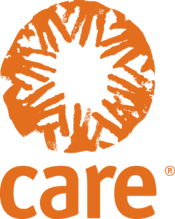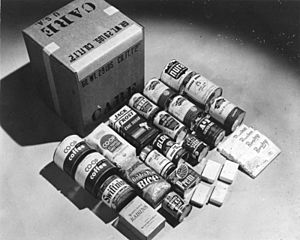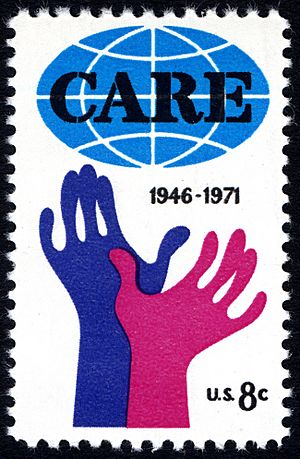Care International facts for kids
CARE (which stands for Cooperative for Assistance and Relief Everywhere) is a big international group that helps people in need. They provide emergency help and work on long-term projects to improve lives around the world.
CARE started in 1945, right after World War II. It's a non-religious, fair, and non-governmental organization. This means it's not run by any government. It's one of the oldest and largest groups fighting global poverty. In 2019, CARE worked in 104 countries. They helped over 92 million people directly and 433 million people indirectly through their projects.
CARE's programs help with many important things. These include:
- Responding to emergencies
- Making sure people have enough food (food security)
- Providing clean water and sanitation
- Helping people earn money (economic development)
- Dealing with climate change
- Supporting agriculture
- Improving education
- Working on global health
CARE also speaks up for poor people's rights and tries to change policies at local, national, and international levels. In all their work, CARE especially focuses on helping and empowering women and girls. They also work to promote gender equality, which means everyone, no matter their gender, has the same opportunities.
CARE International is like a team of fourteen different CARE groups from different countries. Each group is its own non-profit organization.
Contents
How CARE Started and Grew
The First CARE Packages (1945–1949)
CARE began on November 27, 1945. It was first called the "Cooperative for American Remittances to Europe." It was meant to be a temporary group. After World War II ended, many people in Europe were starving. President Harry S. Truman allowed private groups like CARE to send help.
CARE was started by 22 different U.S. charities. These included civic, religious, and labor groups. Their goal was to send food to Europe after the war. They sent their first food packages in 1946.
These food packages were called CARE Packages. At first, people in the U.S. paid $10 to send a package to a specific person in Europe. CARE promised to deliver the package within four months. They even sent back a signed receipt to the sender. This was often the first way people knew their loved ones had survived the war!
The very first CARE Packages were actually extra U.S. army food packs. These packs were designed to feed ten people for a day. In 1946, CARE bought 2.8 million of these packs. They started sending them out on May 11, 1946, to Le Havre, France. These packages had things like canned meats, powdered milk, dried fruits, and fats. They also had a few treats like chocolate and coffee.
By 1947, the army food packs ran out. So, CARE started making its own packages. They worked with a nutritionist to design them. These new packages were sometimes made for specific places. For example, packages for the United Kingdom had tea, and packages for Italy had pasta. By 1949, CARE offered more than twelve different kinds of packages.
Even though CARE first sent packages to specific people, they soon started sending them to "a teacher" or "a hungry person in Europe." This idea of helping anyone in need became a big part of CARE's work.
Between 1946 and 1956, millions of CARE Packages went to Europe. More than half of them went to Germany. Many were even delivered during the Berlin airlift in 1948, when the Soviet Union blocked Berlin.
Later, laws in the U.S. made it easier for groups like CARE to get extra U.S. farm products to send as aid. This helped CARE expand its food programs and disaster relief efforts a lot.
Moving Beyond Europe (1949–1956)
Even though CARE started in Europe, they opened their first office outside Europe in Japan in 1948. They then sent help to China and Korea. In 1949, CARE started working in developing countries for the first time, beginning programs in the Philippines. Soon after, they started projects in India, Pakistan, and Mexico.
In 1949, CARE also started sending more than just food. They created "self-help" packages with tools for farming and carpentry. Because they were helping people everywhere, in 1953, CARE changed what its name stood for to "Cooperative for American Remittances to Everywhere."
As Europe got back on its feet, CARE had to decide what to do next. Some thought CARE should close down. But others believed CARE should keep going and focus on helping developing countries. In 1955, they voted to continue their work outside Europe.
CARE then closed many of its offices in Europe. They focused on sending food and helping in emergencies in developing countries. One of their last big operations in Europe for many years was helping refugees from the Hungarian Revolution of 1956.
Growing into Broader Development Work (1957–1975)
As CARE started working in more places, it also began to do more than just give out food. To show this wider goal, in 1959, CARE changed its name again to "Cooperative for American Relief Everywhere."
In 1961, CARE helped President John F. Kennedy start the Peace Corps. CARE helped choose and train the first group of volunteers. These volunteers went to help with development projects in Colombia.
In 1962, CARE joined with another group called MEDICO, which provided medical aid. This merger greatly increased CARE's ability to offer health programs, including medical staff and supplies.
During this time, the original CARE Package slowly stopped being used. The last food package was sent in 1967, and the last tools package in 1968. Over 100 million CARE Packages had been delivered worldwide! Even though they officially stopped, the idea of the CARE Package was sometimes used again, like when helping people in the former Soviet Union or during the Bosnian War.
In 1967, CARE also started working with governments for the first time. They helped build schools in Honduras. Working with governments meant their programs could help whole countries, not just a few towns. During this time, CARE focused on building schools and nutrition centers, and still giving out food.
By 1975, CARE started using a multi-year plan for its projects. This made programs even bigger and more detailed. Projects became more complete, offering things like health education, clean water, and farming programs to improve nutrition all at once.
From CARE to CARE International (1975–1990)
Even though CARE opened an office in Canada in 1946, it really became an international group in the mid-1970s. CARE Canada became its own group in 1973. Then, CARE Europe was started in 1976. Many Europeans remembered getting help from CARE after the war, which made these new offices popular.
In 1979, people started planning a main organization to help all the different national CARE groups work together. This new group was called CARE International. It first met on January 29, 1982. The first members were CARE Canada, CARE Germany, CARE Norway, and CARE USA.
CARE International grew a lot in the 1980s. CARE France joined in 1983, CARE International UK in 1985, CARE Austria in 1986, and CARE Australia, CARE Denmark, and CARE Japan in 1987.
Recent History (1990–Present)
In the 1980s and early 1990s, CARE also focused on planting trees and protecting soil in places like eastern Africa and South America. CARE also helped during big emergencies, like the famines in Ethiopia (1983–1985) and Somalia (1991–1992).
In the 1990s, CARE's understanding of poverty changed. At first, they thought poverty was just about not having basic things like food or clean water. But they realized that poverty often happens because people are left out, ignored, or treated unfairly. So, CARE started to see poverty as not just about physical things, but also about a person's place in society and their abilities. By 2000, CARE began using a "rights-based approach" to development. This means they focus on helping people get their basic rights.
In 2016, one of CARE's buildings was attacked, and people were hurt. In 2021, after American troops left Afghanistan, there were worries about women and girls. A CARE leader said that women would keep educating their families and neighbors, even "behind the walls," despite new rules.
Helping with Small Loans
In the early 1990s, CARE also created a great way to help people save and borrow money together. This is called the Village Savings and Loans Associations (VSLA). It started in 1991 in Niger.
Here's how it works: Groups of about 15–30 people regularly save money together. This money creates a group fund. Members can then borrow small amounts from this fund for short periods. At the end of a set time (usually about a year), the savings and interest are shared among the group. Then, the groups often start a new cycle. This system is simple to manage, and most groups become independent quickly. CARE has started over 40,000 VSLAs (with over 1 million members) across Africa, Asia, and Latin America.
Other big groups like Oxfam and Plan International have also used this model. CARE UK also launched a website called lendwithcare.org. It lets people give small loans to business owners in Africa and Asia.
New Name and 50th Anniversary
In 1993, to show its international structure, CARE changed what its name stood for a third time. It became the "Cooperative for Assistance and Relief Everywhere," which is its current name. CARE also celebrated its 50th anniversary in 1994.
CARE continued to grow. CARE Netherlands joined in 2001, and CARE Thailand (called the Raks Thai Foundation) joined in 2003. CARE Thailand was the first CARE group from a developing country.
In 2006, CARE launched its "I am Powerful" campaign in the U.S. This campaign wanted to show the public that CARE has always focused on empowering women. CARE believes that women and girls are often the poorest people in the world. They also believe that when women are empowered, it helps everyone, including boys and men.
In 2007, CARE announced that it would stop taking certain types of U.S. food aid. They said these types of aid were not efficient and could harm local markets. For example, they stopped taking food aid that was sold in local markets to fund projects. They wanted to buy more food aid locally instead.
CARE India became a full member in 2013, and CARE Peru became a full member in 2015.
Today, CARE is one of the few big non-governmental organizations that shares its project evaluations with the public. They also regularly check how well their evaluation methods work and how much impact they are having.
How CARE International Works
CARE International is made up of twenty different CARE National Members. The main office, called the CARE International Secretariat, is in Geneva, Switzerland. They also have offices in New York City and Brussels to work with the United Nations and European groups.
Each CARE National Member is its own non-governmental organization in its own country. They run programs, raise money, and communicate both in their home country and in the developing countries where CARE works.
Here are some of the CARE National and Affiliate Members:
| CARE Member | Joined the confederation as of: | Website | |
|---|---|---|---|
| CARE Australia | 1987 | www.care.org.au | |
| CARE Canada | 1946 | www.care.ca | |
| CARE Caucasus | 2021 | http://www.care-caucasus.org.ge/ | |
| CARE Czech Republic | 2021 | https://www.care.cz/ | |
| Chrysalis Sri Lanka * | 2017 | http://chrysaliscatalyz.com/ | |
| CARE Danmark | 1987 | www.care.dk | |
| CARE Deutschland | 1981 | www.care.de | |
| CARE Egypt | 2022 | www.care.org.eg/ | |
| CARE France | 1983 | www.carefrance.org | |
| CARE India | 2011 | www.careindia.org | |
| CARE Indonesia | 2023 | http://www.careindonesia.or.id/ | |
| CARE International Japan | 1987 | www.careintjp.org | |
| CARE Luxemburg | 2022 | https://www.care.lu/ | |
| CARE International Maroc (Morocco) | 2023 | https://www.caremaroc.org/ | |
| CARE Nederland | 2001 | www.carenederland.org | |
| CARE Norge | 1980 | www.care.no | |
| CARE Österreich | 1986 | www.care.at | |
| CARE Peru | 2012 | www.care.org.pe | |
| Raks Thai Foundation (CARE Thailand) | 2003 | www.raksthai.org | |
| CARE International UK | 1985 | www.careinternational.org.uk | |
| CARE USA (founding member: originally simply CARE) | 1945 | www.care.org |
Affiliate members are marked with an asterisk (*)
Where CARE Works
In 2016, CARE was active in many countries around the world. They worked in:
- Asia-Pacific: Afghanistan, Australia, Fiji, Nepal, Bangladesh, Pakistan, Cambodia, Papua New Guinea, Philippines, India, Sri Lanka, Indonesia, Thailand, Laos, Timor-Leste, Japan, Vanuatu, Myanmar, Vietnam.
- East and Central Africa: Burundi, Democratic Republic of the Congo, Ethiopia, Kenya, Rwanda, Somalia, South Sudan, Sudan, Tanzania, and Uganda.
- Latin America and Caribbean: Bolivia, Guatemala, Brazil, Dominican Republic, Haiti, Cuba, Honduras, Ecuador, Nicaragua, El Salvador, Panama, Peru, Mexico.
- Middle East, North Africa and Europe: Albania, Armenia, Austria, Azerbaijan, Belgium, Bosnia and Herzegovina, Croatia, Czech Republic, Denmark, Egypt, France, Georgia, Germany, Iraq, Jordan, Kosovo, Lebanon, Luxemburg, Macedonia, Montenegro, Morocco, Netherlands, Norway, Romania, Serbia, Switzerland, Syria, Turkey, United Arab Emirates, United Kingdom, West Bank and Gaza, and Yemen.
- North America: Canada and the United States of America.
- Southern Africa: Madagascar, Malawi, Mozambique, Zambia, and Zimbabwe.
- West Africa: Benin, Burkina Faso, Cameroon, Chad, Côte d'Ivoire, Ghana, Guinea, Liberia, Mali, Niger, Senegal, Sierra Leone, and Togo.
In these countries, CARE carried out 962 projects. They directly helped over 80 million people!
Here's a quick look at how many people they helped in different regions:
| Region | People Directly Helped | Projects |
|---|---|---|
| East & Central Africa | 9,086,533 | 200 |
| Latin America & Caribbean | 965,705 | 93 |
| Middle East, North Africa & Europe | 3,616,754 | 194 |
| Asia & the Pacific | 56,738,386 | 329 |
| Southern Africa | 4,640,456 | 80 |
| West Africa | 5,072,468 | 137 |
In 2016, CARE had a budget of over 574 million Euros. They had 9,175 staff members, and 94% of them were local citizens of the countries where they worked.
Working with Others
CARE works with many other groups to make sure humanitarian aid is the best it can be. They follow important rules for helping people in disasters. They are also part of groups that aim to improve how aid is given. CARE often joins with other big non-governmental organizations to speak up for important causes, like fighting climate change.
Leaders of CARE
- CEO: Michelle Nunn (since 2015)
Secretaries General
| Date | Name |
|---|---|
| 2020 - Present | Sofia Sprechmann Sineiro |
| 2019 - 2020 | Lindsay Glassco |
| 2018 - 2019 | Caroline Kende-Robb |
| 2018 | Laurie Lee (interim) |
Images for kids
See also
 In Spanish: CARE Internacional para niños
In Spanish: CARE Internacional para niños





